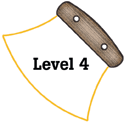
Alaska Science
Key Element A12
 |
Alaska Science |
|
Performance Standard Level 4, Ages 15–18
|
|
|
|
Sample Assessment Ideas
|
|
|
Expanded Sample Assessment Idea
|
|
Procedure Students will:
Reflection and Revision
|
Levels of Performance |
||
|
Stage 4 |
Student work is complete, and shows evidence of logical reasoning. Diagrams are detailed, correctly identify classification schemes for both algae and land plants, and include detailed comparisons of cellular and structural adaptations in both land and aquatic plants. | ||
|
Stage 3
|
Student work shows evidence of logical reasoning but may contain minor errors or omissions. Diagrams correctly identify a classification scheme for both algae and land plants, and compare some cellular or structural adaptations. | ||
|
Stage 2
|
Student work may be incomplete, incorrect, and may contain errors of science fact and reasoning. Diagrams correctly identify algae and land plants and develop a simple classification scheme. | ||
|
Stage 1
|
Student work is largely incomplete, incorrect, or contains evidence of misconceptions related to plants, plant classification, and plant adaptation. | ||
Standards Cross-References
|
||
|
National Science Education Standards The great diversity of organisms is the result of more than 3.5 billion years of evolution which has filled every available niche with life forms. (Page 185) Biological classifications are based on how organisms are related. Organisms are classified into a hierarchy of groups and subgroups based on similarities that reflect their evolutionary relationships. Species is the most fundamental unit of classification. (Page 185) |
Benchmarks The variation of organisms within a species increases the likelihood that at least some members of the species will survive under changed environmental conditions, and a great diversity of species increases the chance that at least some living things will survive in the face of large changes in the environment. (Page 105) The degree of kinship between organisms or species can be estimated from the similarity of their DNA sequences, which often closely matches their classification which is based on anatomical similarities. (Page 105) |
|
Table of Contents | Return to Alaska Native Knowledge Network